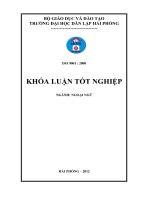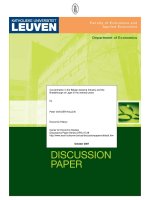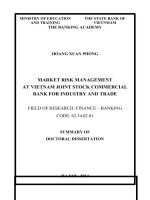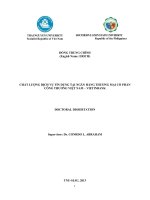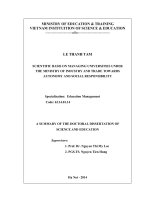Asseeement of the quality management training of universities under the ministry of industry and trade
Bạn đang xem bản rút gọn của tài liệu. Xem và tải ngay bản đầy đủ của tài liệu tại đây (473.29 KB, 96 trang )
ASSESSMENT OF THE QUALITY MANAGEMENT TRAININGS
OF UNIVERSITIES UNDER THE MINISTRY OF
INDUSTRYAND TRADE
___________________________
A DISSERTATION
Presented to the Faculty of the Graduate School
Southern Luzon State University, Lucban, Quezon, Philippines
in Collaboration with
Thai Nguyen University, Socialist Republic of Vietnam
___________________________
In Partial Fulfillment
of the Requirements for the Degree
Doctor of Philosophy in Educational Management
___________________________
By
BUI QUANG CHUYEN (FABLE)
October 2014
i
APPROVAL SHEET
ii
CERTIFICATE OF ORIGINALITY
iii
ACKNOWLEDGMENT
The researcher wishes to convey her gratitude to the following persons
who wholeheartedly devoted and helped make this piece of work a reality:
DR. TERESITA V. DE LA CRUZ, her adviser for the guidance, supervision,
suggestions and precious time in enthusiastically reading and checking
the manuscript, providing the researcher useful materials;
DR. CECILIA N. GASCON, president of the Southern Luzon State University
in the Philippines, for her incomparable contribution and support to the
development of the Doctor of Philosophy in Educational Management
program in Thai Nguyen University;
DR. NGUYEN VAN BINH, director of the International Training Center, Thai
Nguyen University of Socialist Republic of Vietnam, for his enormous
pursuit to provide Vietnamese people an opportunity to grow through
education;
DR. WALBERTO A. MACARAAN, DR.RICARYL CATHERINE P. CRUZ, DR.
APOLONIA A. ESPINOSA, and DR. BELLA R. MUELLO, panelists,
for constructive criticism and valuable comments and suggestions to
improve the study;
PROFESSORS of Southern Luzon State University and for the valuable
knowledge, pieces of advice, suggestions and moral support;
MIT FACULTY and STUDENTS for the assistance and cooperation in
providing the data for this study; and
iv
His FAMILY and FRIENDS, for the love and support in one way or another;
and to all who have contributed to make this study possible.
BQC
v
DEDICATION
To my
Beloved parents,
Siblings,
Relatives
And
Most especially
To my
Loving Wife and Children
For their endless support
And for being my constant source of inspiration
BQC
vi
TABLE OF CONTENTS
PAGE
TITLE PAGE ………………………………………………………………..
i
APPROVAL SHEET ……………………………………………………….
ii
CERTIFICATE OF ORIGINALITY ………………………………………..
iii
ACKNOWLEDGMENT …………………………………………………..
iv
DEDICATION ………………………………………………………………
vi
TABLE OF CONTENTS …………………………………………………..
vii
LIST OF TABLES ………………………………………………………….
ix
LIST OF FIGURES…………………………………………………………
xi
LIST OF APPENDICES …………………………………………………...
xii
ABSTRACT …………………………………………………………………
xiii
CHAPTER
I
II
III
IV
INTRODUCTION ……………………………………………
1
Background of the Study ……………………….…………..
6
Objectives of the Study ……………………………….…….
7
Significance of the Study …………………………………...
8
Scope and Limitation of the Study …………………….…..
9
Definition of Terms …………………………………………..
10
REVIEW OF LITERATURE ……………………….……….
12
Research Paradigm ……………………………...….………
31
METHODOLOGY ……………………………………………
33
Locale of the Study ………………………….………………
33
Research Design …………………………….………………
33
Population and Sampling ………………….…...…………..
34
Instrumentation………………………...…………..…….….
34
Data Gathering Procedure ………………………………….
34
Statistical Treatment …….…………………………………..
35
RESULTS AND DISCUSSIONS ……………………….….
36
vii
Quality Management Trainings of the Universities under
MOIT ………………………………………………………….
Proposed Enhancement Program on the Quality
Management of the Universities under Ministry of
Industry and Trade …………………………………………..
Acceptability of the Proposed Enhancement Program ….
V
36
55
59
SUMMARY, FINDINGS, CONCLUSIONS AND
RECOMMENDATIONS
Summary …………………..…………………………………
64
Findings…………………….………..…………………….…
65
Conclusions ……………………………………………….…
65
Recommendations ……………………………………..……
66
REFERENCES ……………………………………………………………..
67
APPENDICES ……………………………………………………………...
69
CURRICULUM VITAE …………………………………………………….
82
viii
LIST OF TABLES
TABLE
1.1
1.2
1.3
1.4
1.5
PAGE
Frequency and Mean Distribution of Assessment of Quality
Management Trainings of the Universities under MOIT as to
Mission and Goals ……………………………………………….
37
Frequency and Mean Distribution of Assessment of Quality
Management Trainings of the Universities under MOIT as to
Education Program ………………………………………………
38
Frequency and Mean Distribution of Assessment of Quality
Management Trainings of the Universities under MOIT as to
Training Activities………………………………………………..
41
Frequency and Mean Distribution of Assessment of Quality
Management Trainings of the Universities under MOIT as to
Management of Staff and Faculty ……………………………...
44
Frequency and Mean Distribution of Assessment of Quality
Management Trainings of the Universities under MOIT as to
Scientific Research Application Development and
Technology Transfer…………………………………………….
46
48
1.6
Frequency and Mean Distribution of Assessment of Quality
Management Trainings of the Universities under MOIT as to
Learning Facilities
and Equipment
1.7
Frequency and Mean Distribution of Assessment of Quality
Management Trainings of the Universities under MOIT as to
Education Program by the Students…………………………..
50
Frequency and Mean Distribution of Assessment of Quality
Management Trainings of the Universities under MOIT as to
Learning Equipments and Facilities by the Students ………..
52
Frequency and Weighted Mean Distribution on the
Acceptability of the Proposed Enhancement Program for the
Universities under MOIT as to Objectives …………………….
59
Frequency and Weighted Mean Distribution on the
Acceptability of the Proposed Enhancement Program for the
Universities under MOIT as to Contents ………………………
60
Frequency and Weighted Mean Distribution on the
Acceptability of the Proposed Enhancement Program for the
Universities under MOIT as to Strategies ……………………..
61
1.8
2.1
2.2
2.3
ix
TABLE
2.4
PAGE
Frequency and Weighted Mean Distribution on the
Acceptability of the Proposed Enhancement Program for the
Universities under MOIT as to Evaluation…………………….
x
62
LIST OF FIGURE
FIGURE
1
PAGE
Modified Input-Process-Output (IPO) Model on the
Assessment of the Quality Management Training of the
University under MOIT ………………………………………….
xi
32
LIST OF APPENDICES
APPENDIX
PAGE
A
Communications …………………………………………….
70
B
Instrument …………………………………………………….
72
C
Computations ....................................................................
76
xii
ABSTRACT
Title of Research
: ASSESSMENT OF THE QUALITY MANAGEMENT
TRAININGS OF UNIVERSITIES UNDER
MINISTRY OF INDUSTRY AND TRADE
Researcher
: BUI QUANG CHUYEN (FABLE)
Degree Conferred
: DOCTOR OF PHILOSOPHY IN EDUCATIONAL
MANAGEMENT
Name and Address
of Institution
: Southern Luzon State University Lucban, Quezon,
Philippines and Thai Nguyen University, Socialist
Republic of Vietnam
Adviser
: Dr. Teresita V. de la Cruz
Year Written
: 2014
______________________________________________________________
The study sought to assess quality management training of universities
under MOIT. Specifically, the study aimed to evaluate quality management
training of the universities under MOIT in terms of mission and goal, education
program, training activities, management of staff as well as faculty, research
application development and technology transfer and learning equipment and
facilities. An enhancement program is proposed based on the result of the
survey which was evaluated by the experts. The study was conducted in eight
(8) selected universities by Ministry of Industry and Trade including the Hanoi
University of Industry, University of Economics and Industrial Technical,
University of QuangNinh Industrial, University of Industry of Ho Chi Minh City,
University of Food Industry of Ho Chi Minh, University Industry of Vietnam –
Hungary, University of Sao Do, and University of Industry of Viet Tri and
utilized descriptive method of research. The respondents of the study were
200 education managers and 40 students. The researcher utilized quantitative
approach of research wherein he used validated questionnaires to gather the
xiii
needed data. The gathered data were tallied, tabulated, statistically analyzed
using weighted mean, and interpreted. It was shown that quality management
trainings of universities under the MOIT are rated 3.40 (SA) for mission and
goals, 2.61 (A) for education program, 2.55 (A) for training and activities, 2.66
(A) management of staff and faculty, 2.76 (A) scientific research application
development and technology transfer, and 2.70 (A) for learning facilities and
equipment. It is determined that the proposed enhancement program is
accepted as indicated by the average weighted mean of 3.26. Thus, quality
management trainings of universities under MOIT have clear statements of
mission and goal, but need to improve and give attention on the education
program, training activities, management of the staff and faculty, scientific
research application development and technology transfer, and its learning
equipment and facilities. The developed enhancement program is ready for
initial implementation. However, it was recommended that assessment of the
quality management training may be done annually. The learning equipment
and facilities may be given greater priority by the educational managers. The
developed enhancement program for the universities under the MOIT may be
adopted by the subjected institutions.
xiv
1
Chapter I
INTRODUCTION
In past years, Vietnam’s education and training sectors have achieved
significant accomplishments considering the size and quality of trainings
which showed an increasing demand for technical labor force by economic
sector, manufacturing and services. The trainings at university levels had
gradually been strengthened resulting to significant management changes.
Quality training is the prime concern of the whole society but it has
posed many problems which need to be solved particularly in the scope of
state management and school management. Training facility has been directly
created and has taken the responsibility for the quality of training. However,
higher education sectors also revealed many shortcomings and weaknesses,
such as: the quality of education is generally low which is not responsive to
demands of social and economic development of the country; management
mechanism of State for higher education system and the management of
universities and colleges is unreasonably prolonged and does not create a
strong motivation to develop the creative capacity and responsibility among
faculty members, managers and students. It is also a verity that the social
investment and potential foreign investors for the development of the higher
education has not been promoted effectively.
In the international context, the world is moving toward revolution in
industrialization and automation, taken as a dynamic knowledge development.
The development of science and technology has drastically changed content
and methods of education in schools, and requires the higher education to
provide highly qualified human resources for society.
2
While in domestic context, in terms of the opportunities, after nearly 30
years of innovation, the country entered a period of strong growth with the
new position and appearance. Vietnam’s continuous economic development;
national security and well-maintained economic structure continue to shift
towards strengthening the industry and services. People's lives are improved
markedly. Vietnam is actively involved in a process of international integration
with high economic growth rate, with the stable political environment and the
standard of living of all classes of the people is increasingly improving. The
positive active international integration, and joined World Trade Organization
(WTO) in 2007 has created more favorable conditions for the socio-economic
development process of the country.
However, despite the significant growth, the Vietnamese economy is
still suffering from low-income economies. Indicators of infrastructure, human
development is still ranked lower than many countries in the world. Labor
productivity is low; production is still mainly based on outdated technology,
products as raw materials, high cost, low value added. Economic structure
has shifted but still slow: the share of services and industry in GDP is low.
This as well as social development did not meet the requirements. Effective
management for many areas of socio-economic, health and education are
limited. International cooperation is extended to bring increased investment of
countries, international organizations and foreign enterprises, increase the
demand for the labor recruitment through training, creating opportunities for
educational development
Integration process in the education taking place on a global scale to
create favorable opportunities for Vietnam can quickly access to new trends,
3
new knowledge, modern model of education, take advantage of international
experience to develop and narrow the development gap between Vietnam
and other countries. The contribution of the state's resources and people for
the development of education is increasingly enhanced. Many of economic
sectors are willing to contribute to the cause of higher education in Vietnam.
Learning needs at university level of people (especially young people
between the ages of 18-45) are great. The needs of the business enterprise
production-qualified labor needed commercial business, professional skills,
meet requirements of operation and exploitation of advanced technological
devices is university. Therefore, requiring the university should have strategy
to develop the school to ensure both quantity and quality of training.
Looking at the challenges, with the strong development of the scientific
revolution, the technology in a world can make the economic and knowledge
gap between Vietnam and other countries increasingly larger, Vietnam at risk
of lagging further. Education management capacity of Vietnam is weak, the
lack of appropriate policies and measures to guide and monitor closely the
educational institutions with foreign elements.
Requirements of economic development in the coming years require
not only the number but also require high quality of human resources. To
continue to grow over the threshold of the low-income country, Vietnam needs
to restructure its economy, products development and value-added services
and high technology. This requires the country to have sufficient qualified
manpower engineering and technology. Currently, Vietnam has more than
63% of working-age population, but the level of labor force both in knowledge
and professional skills is still low compared to many countries in the region.
4
The country lacks highly qualified manpower in various fields, especially the
field of electrical, electronic and information technology. Etc. The structure of
the workforce through training (university / high school / vocational training) is
not reasonable. Demand of trained manpower is increasing in both quantity
and quality with reasonable structure is creating enormous pressure for higher
education.
The Ministry of Industry and Trade (MOIT) was re-established in 2007,
on the basis of merging two ministries (Ministry of Industry and Ministry of
Commerce). The functions, tasks, powers and organizational structure of the
Ministry of Industry and Trade are clearly defined to comply with provisions of
Decree No. 95/2012/ND-CP, 12 November 2012 (the Decree replaces Decree
No.189/2007/ND-CP of December 27, 2007 of government were consistent
with the functions, tasks, powers and organizational structure of the Ministry
of Industry and Trade Decree No. 44/2011/ND-CP of June 14 in 2011).
The MOIT is an agency of the Government, performing the function of
state management of industry and commerce, including the sectors and fields:
mechanical engineering, metallurgy, electricity, new energy, chemicals, oil
and gas, renewable energy, mining and mineral processing, industrial
explosives, consumer industry, food industry and other processing industries,
export, border trade, commercial and domestic markets; e-commerce, foreign
market development, market management, business services, international
economic integration, trade promotion, competition management, application
of measures safeguard, anti-dumping, anti-subsidy and to protect the interests
of consumers; state management of public services in sectors under the state
management.
5
It is envisioned that by 2020, a number of personnel will train for
undergraduate and graduate education of industry and trade with a total of
approximately 800,000 people (up 7.26%). Therefore, to meet the quality of
human resources for the sector, the issue of quality management training is
given urgent consideration, requiring universities to develop similar training
contents, medium scale, and to diversify the types of training to ensure quality
training. So far, no unit or individual study on quality management solutions
training of the university under the Ministry of Industry and Trade has been
conducted with complete and detailed solutions; thus, a study of management
solutions on quality of training of the university under the MOIT is essential.
By 2020, Vietnam will basically become a modern industrial country
following university requirements of the Ministry to train and provide technical
qualified human resources for heavy industry, light industry (including textiles;
footwear; food processing,and beverage), energy, and economics, business
administration, etc. Industrial and Commercial sector labor demand is huge,
but the university failed to meet the requirements for the quantity and quality
of training. Therefore, this studywould be also a way to propose assessment
of quality training of the universities under the MOIT.
In fact today, many graduates cannot find jobs or left with specialized
training. One of the reasons is the quality of education; especially the quality
of training of the human resources cannot meet the people's wishes and
expectations as well as requirements of industrialization, modernization and
international integration sectors. Overall, the quality of graduates is limited,
professional practice skills, information technology skills, language ability and
social activities of students did not meet the requirements of the employer.
6
Background of the Study
As of today, Ministry of Industry and Trade has 8 universities and these
are established on the basis of the upgrade from college and are derived from
the secondary schools, professional training mainly engineering, technology
and economic management, direct service for businesses.In fact, through
testing and evaluation over the years, the management of the quality of higher
education in universities of MOIT are as follows:
The advantages are the university building, the construction of training
program, gradually changing teaching and learning methods, infrastructure
investment and training facilities, consolidate construction teachers develop
proficiency standards, scientific research cooperation and technology transfer.
On the other hand, the disadvantages are that every year, there is no a
realistic assessment and reporting on the quality of education in general and
higher education system in particular since there is no standard output of the
university, not quantitative standards of teachers, programs, facilities and the
likes; there is no solution implemented urge origin and destiny of the target,
which is not considered a key objective; not fully developed training programs
in the field of study curriculum prescribed by Ministry of Education; teaching
and learning activities is not so effective quality graduate students did not
meet the requirements of the business; majority of producers must retrain
knowledge and practical skills; management of faculty, administrators, staff
are not close and not sure about the number of standards and qualifications in
accordance with the Charter of the University; scientific research, technology
transfer is not a focus school leaders, respected; lack of policies and working
conditions to encourage scientific research of students and faculty; equipment
7
and insufficient teaching and learning just outdated, because there is no
funding for investment and procurement should affect the quality of training;
due derived from secondary schools, colleges and universities should be
upgraded to the experience of management staff is limited (only 2 Industrial
University Ho Chi Minh City and Hanoi University of Industry Furniture was
established over 7 years and 6 other universities renovated 3-4 years). So just
admit the number of trainers and short, medium weak, especially a lack of
faculty with doctoral qualifications; curriculum is largely technology transfer, in
the early years of teaching staff not undertake the compilation of programs,
training materials in the university; outdated teaching methods, inappropriate,
scientific research activity is weak and ineffective and; outdated facilities,
discrete, the competitiveness with less specialized universities, especially the
recruitment, jobs for graduates; every year, report does not have a realistic
assessment of the quality of education in general and university education
system in particular. From the Central Government (Ministry of Education and
Training, the Ministry of Industry and Trade) to the base of higher education is
no agency in charge of quality management training.
For these reasons, the researcher chose to delve with the assessment
of management quality trainings of universities under the Ministry of Industry
and Trade with a hope tocontribute to enhance the contents of management
quality training of universities.
Objectives of the Study
This study was focused on the assessment of the quality management
trainings of the universities under the MOIT, for the school year. Specifically, it
sought to attain the following objectives:
8
1. Assess the quality management trainings of universities under the
MOIT in terms of:
1.1 Mission and goal;
1.2 Education program;
1.3 Training activities;
1.4 Scientific research application development and technology
transfer;
1.5 Management of staff and faculty; and
1.6 Learning equipment and facilities.
2. Develop an enhancement program based from the results of the study.
3. Evaluate the enhancement program by experts on the field.
Significance of the Study
This study would be of significance to the managers, university leaders,
faculty and students, and head of business enterprise production, as to the
following respects:
Managers.Through this research, the managers shall be assisted in
assessment of the quality management trainings of the universities and at the
same time would serve as legal basis for assessment of the quality of training
based on the devised policies.
University leaders. From this research, the university leaders would
be able to build and design mission of the university management in providing
quality management training. Hence, the application of solution might improve
the quality of education in universities.
Faculty. This study would help the teachers understand their roles and
responsibilities in improving of assessment the quality management training. It
9
would help them know that good quality training, along with other measures,
requires good teaching staff, the ability to guide and equipped with the proper
knowledge and skills for the advancement of students.
Students. Students would also be directly benefited from this study.
The investment of money, effort, time to get quality of knowledge, professional
skills in their learning and research at the university may be envisioned as
profitable. Upon completion, the graduate students may apply the knowledge
learned to practical production-business.
Head of business enterprise production. This study would help the
businesses to select the qualified human resources (knowledge, skills, and
attitudes) in their recruitment strategy. At the same time, the business sectors
shall be able to have a clear idea on their roles and responsibilities in financial
aspects/contributions, as well as to facilitate the location and environment for
students for domestic practice, thus, improving quality of training of students.
Scope and Limitations
This study focused on the assessment of quality management trainings
of the universities under the MOIT at Vietnam. There were only 15 education
managers, 10 faculty members and five (5) students for each of the eight (8)
universities with a total 240 respondents involved in the study.
The instrument used in this study was the questionnaire which was
adopted by the researcher to answer the quality management trainings of the
universities under the MOIT. The variables used for the assessment were the
mission and goal, education program, training activities, management of staff
and faculty, scientific research application development and technology
10
transfer, learning equipment and facilities. This study utilized weighted mean
distribution to quantitatively analyze the data gathered.
This study was conducted from May 2013 to June 2014.
Definitions of Terms
The following terms are defined conceptually and operationally for the
clarity of the study among the readers:
Assessment can be defined as a general term embracing all methods used
to judge the performance of a group, an organization or an individual.
Education program is written formally in this study with the defined goals,
objectives, requirements, the content knowledge and skills, the overall
structure of the subject, and grade level planning practice every year
high ratio between subjects, between theory and practice, prescribed
methods, methods, means, facilities, certificates, and diplomas of the
educational institutions and training.
Enhancement programmeans strengthening and making something better of
which program is in existence. In this study, the focus is the quality
management training of universities under the MOIT.
Learning equipment and facilities is enabling the teacher to do his/ her
work very well and helping the learners to learn effectively. Equipment
and facilities also include school building, classrooms, assembly halls,
libraries, laboratories, workshops, materials and information technology
are sufficient. Equipment and facilities to support teaching and learning
for training and research, be sure to use quality and efficient service to
meet the requirements for teaching and learning.
11
Management is the way of organizing control, impact of management objects
subject to management in order to effectively Achieve Objectives set
by the organization.
Management of staff and faculty are managed in terms of quantity, content
and tasks of the staff and teachers to undertake the scientific research
development and application and technology transfer activities of the
staff, teachers and students’ research and contributions to science,
valuable practical applications to solve economic development.
Mission and goalis the content and mission statement to work towards the
objectives, the goal to achieve targets. It is an indication that subject
request (the school, the school) should be achieved after a process of
training and learning. These requirements are presented as a model of
how to take into account the standard of education and the training
systems, a large set of characteristics predicted or sustainable change
will occur in an important group of all possible after a learning process.
Quality management trainingis designed to ensure the results of training
activities to achieve educational goals. Quality management training is
done through the process of evaluating the results of the education and
training of students, student performance evaluation of the schools and
educational institutions.
Training Activities are teaching and learning in schools to a new direction to
achieve goals. Training activities reproducespersonality and energy
needs of the curve to maintain social development, human perfection
though measures may impact system, a method to human subjects to
establish, on the moral, mental and physical development.


